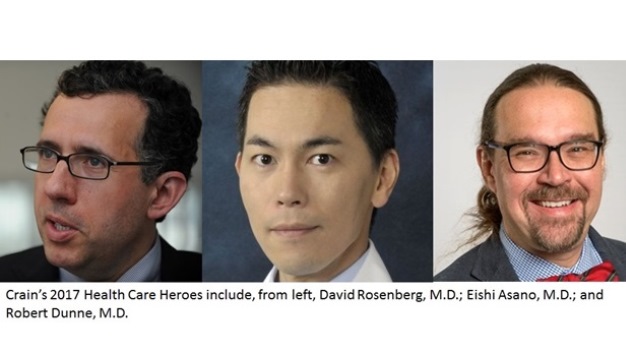
Three members of the Wayne State University School of Medicine faculty have been named 2017 Health Care Heroes by Crain's Detroit Business magazine.
David Rosenberg, M.D., chair of the Department of Psychiatry and Behavioral Neurosciences and the Miriam L. Hamburger Endowed Chair of Child Psychiatry, and Eishi Asano, M.D., professor of Pediatrics and of Neurology, shared the title in the category of Other Health Services Research.
Robert Dunne, M.D., F.A.E.M.S., F.A.C.E.P., clinical associate professor of Emergency Medicine, won the Heart and Vascular Research category.
"I am both honored and humbled by this award," Dr. Rosenberg said. "The real health care heroes, though, are the many WSU students and alumni who graduate and practice medicine here in Michigan. I was 5 years old when our family moved to the Lafayette co-op in Detroit. Being able to serve and work in our community and participate in Detroit's renaissance has been an honor and a privilege. The vision, leadership and commitment of President (M. Roy) Wilson, Dean (Jack D.) Sobel and many others has created an environment where health care heroes can thrive. It's also why WSU is where the action is!"
Dr. Rosenberg was recognized for his work in treating pediatric and adolescent obsessive compulsive disorder. He discovered that abnormalities in specific genes lead to brain glutamate abnormalities that can be measured with magnetic resonance imaging and how glutamate abnormalities disrupt the structure, chemistry and functioning of the brain's arousal center, the anterior cingulate cortex, leading to pediatric and adolescent OCD.
He treats the childhood victims of these conditions. Based in part on initial findings showing glutamate abnormalities in OCD, new treatment approaches utilize drugs such as riluzole, which is used for treating Lou Gehrig's disease. The glutamate research published by Dr. Rosenberg's team was selected by Faculty of 1000 Medicine as one of the most important articles published in the field of medicine. Faculty of 1000 Medicine identifies and evaluates what it considers the most important articles published in medicine based on the recommendations of a faculty of 2,400 peer-nominated leading researchers and clinicians.
His research and that of his team are facilitated by the unique and state-of-the-art magnetic resonance imaging infrastructure at WSU, and the expertise of internationally-recognized scientists and MRI experts Vaibhav Diwadkar, Ph.D., and Jeffrey Stanley, Ph.D., department faculty members who are conducting pioneering and sophisticated MRI imaging studies that are unlocking potential mechanisms for a wide variety of neuropsychiatric disorders.
Dr. Rosenberg has appeared on ABC's "Primetime" and "20/20," most recently on May 19, to discuss childhood and adolescent obsessive compulsive disorder and its variations, including compulsive internet addiction. His pioneering studies into OCD using MRI techniques have led him over the last decade to become a national leader in this topic and its research.
Read the article about Dr. Rosenberg here.
Dr. Asano was selected for developing 3-D and 4-D electronic technology that can create a map of neurons across the speech and language centers of the brain. The technique represents a significant breakthrough in the effort to prevent both pediatric and adult patients who struggle with epilepsy or tumors from experiencing speech and language deficits that can result from corrective surgery performed in those areas of the brain.
After 10 years of continuous work, the team led by Dr. Asano, who also serves as director of Neurodiagnostics for the Children's Hospital of Michigan, developed a set of electronic tools that can draw "space- and time-based" maps of the neuron-signaling across speech and language centers of the human brain. This is believed to be the first time that neurology researchers have been able to look at the origin and propagation of electro-signaling related to speech and language centers at the whole-brain level at a temporal resolution that will improve the quality of life in patients undergoing surgery to reduce epileptic seizures or remove brain tumors.
The new mapping technology will significantly reduce the risk of language deficits after surgery. For both pediatric and adult patients, avoiding such deficits following brain surgery is extremely important for quality of life.
"I feel honored to receive this award," Dr. Asano said. "I would like to give massive credit to the epilepsy care members, including those in the neurology, neurosurgery, neurodiagnostics, psychology, imaging, pathology, intensive care unit, anesthesiology and rehabilitation departments, who have been dedicated to the care of patients with drug-resistant epilepsy for more than a decade. Without their support, we would not have been able to improve the brain-mapping technology as such."
The breakthrough was published in March in Brain, a leading international scientific journal based in the United Kingdom.
The technique is child-friendly and readily applicable to young children who may not be cooperative enough to undergo conventional mapping examinations.
Read the article about Dr. Asano here.
Robert Dunne, M.D., F.A.E.M.S., F.A.C.E.P., was recognized for improving the cardiac arrest survival rate in the city of Detroit.
Dr. Dunne, vice chief of Emergency Medicine for the St. John Hospital and Medical Center, and Emergency Medical Services Fellowship director for the WSU School of Medicine's Department of Emergency Medicine, worked with the city of Detroit and WSU to create a cardiac arrest registry. The registry allows researchers to track and compare the quality of EMS response in cardiac arrest cases.
Because most cardiac arrest cases begin with a call to 911 and some providing cardiopulmonary resuscitation to the victim before an EMS crew arrives, Dr. Dunne worked to secure grants to devise programs to educate city residents in proper CPR techniques, in addition to training 911 operators to provide CPR coaching during emergency calls.
"It is great to be recognized by whomever nominated me, but I really want to thank the team I work with at the city, the university and the hospitals," Dr. Dunne said. "Sustained effort from many people is the only way we have been able to make improvements. I also encourage everyone to learn CPR and recognize cardiac arrest."
Read the article on Dr. Dunne here.